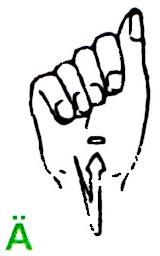Ä
![]()
This article is about the Latin letter. For other meanings, see Ä (disambiguation).
Ahem
The Ä (lower case ä, also called a-Umlaut) is a letter of the Latin writing system. It represents an A with an umlaut or an A with a trema.
The A with umlaut was first written as AE, partly contracted (Æ/æ). Later it developed into an A with a small E above it (Aͤ/aͤ). The small e was written as two vertical strokes in the further development of the Kurrent script, as well as the small e above the A. This way of writing has been preserved in the cursive script (and in Fraktur scripts) until today. In the antiqua script, the overwritten e was stylized into two dots.
The finger alphabet for the deaf or hard of hearing represents the letter Ä in the form of a closed fist with the thumb pointing upwards and making a short downward movement.
In good print, the umlaut dots differ from the two dots of the tremolo: the umlaut dots are smaller, closer together, and slightly lower.
In the German alphabet, the A with umlaut, the umlaut letter Ä, is usually pronounced /ɛ/.
In Finnish and Estonian, the letter is considered independent and not an A with trema. Accordingly, it cannot be written out as ae if the character is not available. The pronunciation is always /æ/.
The Slovak language also has an Ä, which is pronounced /ɛ/.
In Chinese transliterations for the Nanjing dialect of Mandarin, the Ä also stands for the /ɛ/ sound.
In Swedish, similar to Finnish, the Ä is a letter in its own right (but can be written out as ae if necessary). If it is followed by an R, the letter is pronounced /æ/, otherwise the pronunciation is /ɛ/.
In some Turkic languages that use the letter Ə, the Ä can be used as a substitute for the Ə. In the Turkmen language, the Ä has now officially replaced the Ə.

Letter Ä in the finger alphabet
Display on the computer
Unicode contains the Ä at code points U+00C4 (uppercase) and U+00E4 (lowercase). In ISO 8859-1, the letter is encoded in the same places.
Older programs, which are still based on US-ASCII, for example, cannot represent ä or Ä. Here these characters are usually replaced by an ae or AE.
In TeX you can insert the Ä in text typesetting with the commands \"A and \"a or in graphical typesetting with \ddot A and \ddot a. With the package german.sty or with the package babel the input of the German umlauts to "a, "o and "u is simplified. By specifying a suitable option for the inputenc package, it is also possible to enter the umlauts directly in text mode.
In HTML there are the named characters Ä for the Ä and ä for the ä.
On Windows, you can also enter the capital Ä by using the combination Alt+142, and the lowercase ä by using the combination Alt+132. On Linux systems with newer versions of X11, the letter can be entered by Compose, ⇧Shift, 2a.
Aͤaͤ
The old German Aͤ/aͤ can be set with U+0364 COMBINING LATIN SMALL LETTER E (Unicode block Combining diacritical marks - ͤ following the respective letter).
See also
![]() Wiktionary: Ä - meaning explanations, word origin, synonyms, translations
Wiktionary: Ä - meaning explanations, word origin, synonyms, translations
![]() Wiktionary: ä - meaning explanations, word origin, synonyms, translations
Wiktionary: ä - meaning explanations, word origin, synonyms, translations
basic Latin alphabet
Aa Bb Cc Dd Ee Ff Gg Hh Ii Jj Kk Ll Mm Nn Oo Pp Qq Rr Ss Tt Uu Vv Ww Xx Yy Zz
See also: Latin writing system and list of Latin alphabets
Letters derived from the Latin A
Àà Áá Ââ Ãã Ää Åå Ǻǻ Āā Ăă Ąą Ǎǎ Ǟǟ Ǡǡ Ȁȁ Ȧȧ Ⱥⱥ Ḁḁ ẚ Ạạ Ảả Ấấ Ầầ Ấấ Ẩẩ Ẫẫ Ậậ Ắắ Ằằ Ẳẳ Ẵẵ Ặặ Ææ Ǽǽ Ǣǣ Ɑɑ Ɐɐ Ɒɒ A̱a̱ A̮a̮ Aͤaͤ
Search within the encyclopedia